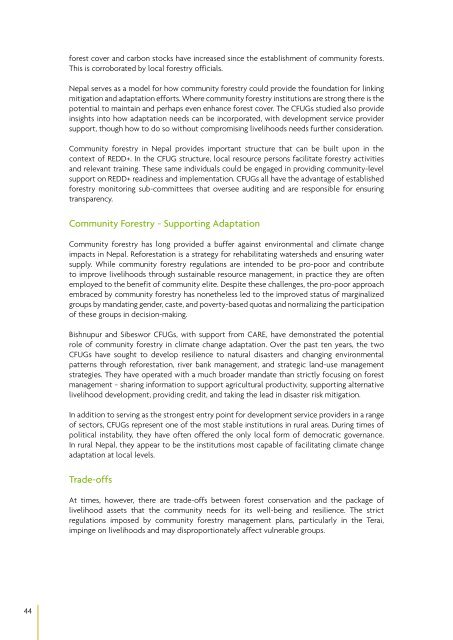Adaptation case studies.pdf - RECOFTC
Adaptation case studies.pdf - RECOFTC
Adaptation case studies.pdf - RECOFTC
You also want an ePaper? Increase the reach of your titles
YUMPU automatically turns print PDFs into web optimized ePapers that Google loves.
forest cover and carbon stocks have increased since the establishment of community forests.This is corroborated by local forestry officials.Nepal serves as a model for how community forestry could provide the foundation for linkingmitigation and adaptation efforts. Where community forestry institutions are strong there is thepotential to maintain and perhaps even enhance forest cover. The CFUGs studied also provideinsights into how adaptation needs can be incorporated, with development service providersupport, though how to do so without compromising livelihoods needs further consideration.Community forestry in Nepal provides important structure that can be built upon in thecontext of REDD+. In the CFUG structure, local resource persons facilitate forestry activitiesand relevant training. These same individuals could be engaged in providing community-levelsupport on REDD+ readiness and implementation. CFUGs all have the advantage of establishedforestry monitoring sub-committees that oversee auditing and are responsible for ensuringtransparency.Community Forestry − Supporting <strong>Adaptation</strong>Community forestry has long provided a buffer against environmental and climate changeimpacts in Nepal. Reforestation is a strategy for rehabilitating watersheds and ensuring watersupply. While community forestry regulations are intended to be pro-poor and contributeto improve livelihoods through sustainable resource management, in practice they are oftenemployed to the benefit of community elite. Despite these challenges, the pro-poor approachembraced by community forestry has nonetheless led to the improved status of marginalizedgroups by mandating gender, caste, and poverty-based quotas and normalizing the participationof these groups in decision-making.Bishnupur and Sibeswor CFUGs, with support from CARE, have demonstrated the potentialrole of community forestry in climate change adaptation. Over the past ten years, the twoCFUGs have sought to develop resilience to natural disasters and changing environmentalpatterns through reforestation, river bank management, and strategic land-use managementstrategies. They have operated with a much broader mandate than strictly focusing on forestmanagement − sharing information to support agricultural productivity, supporting alternativelivelihood development, providing credit, and taking the lead in disaster risk mitigation.In addition to serving as the strongest entry point for development service providers in a rangeof sectors, CFUGs represent one of the most stable institutions in rural areas. During times ofpolitical instability, they have often offered the only local form of democratic governance.In rural Nepal, they appear to be the institutions most capable of facilitating climate changeadaptation at local levels.Trade-offsAt times, however, there are trade-offs between forest conservation and the package oflivelihood assets that the community needs for its well-being and resilience. The strictregulations imposed by community forestry management plans, particularly in the Terai,impinge on livelihoods and may disproportionately affect vulnerable groups.44
















